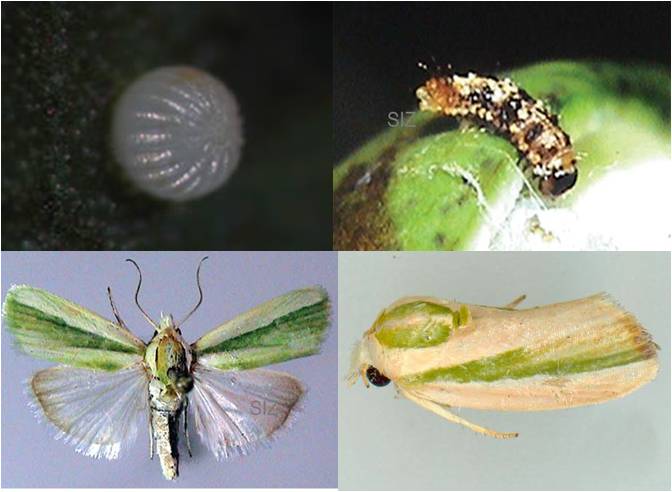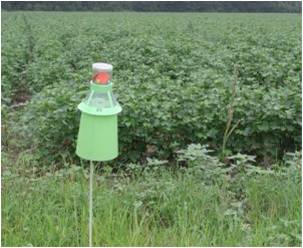|
Pests of Cotton :: Major Pests :: American bollworm/Green bollworm
2. American bollworm/Green bollworm: Helicoverpa armigera (Noctuidae:Lepidoptera)
Distribution and status: Cosmopolitan. Major pest
Host range: Sorghum, lablab, soybean, peas, sunflower, safflower, chillies, groundnut, tobacco, bhendi, maize, tomato.
Damage symptoms
The caterpillars feed on leaves, squares, flowers and small bolls. When the squares, flowers and bolls are attacked, they feed the internal content completely by thrusting their head inside leaving the rest of the body outside. The damaged squares and young bolls drop away from the plants. The developed bolls and open bolls are not attacked. |
|
Economic threshold level: 10% of affected fruiting parts or bolls or one egg/plant or one larva/plant
Bionomics
Adult: Brown coloured moth with a ‘V’ shaped speck on forewing and dull black border on the hind wing. Eggs are laid on the host plants singly. The egg period is 7 days. Full grown larva is 2” long, greenish with dark brown gray lines and dark and pale bands. It shows colour variation from greenish to brown. The larval duration is 14 days. It pupates in soil for 10 days. |
|
Bionomics
Earias vittella has green forewigns with white streak in each of them.
Earias insulana has complete green forewings
Scuptured, crown shaped, deep sky blue colour eggs are deposited singly on the shoot tips, buds, flowers, fruits. Egg period is 3 days Larva is brown with dorsum showing a white median longitudinal streak; the last two thoracic segments and all the abdominal segments have two pairs of fleshy tubercles (finger shaped processes), one dorsal and the other lateral. E. vittella is without finger shaped processes. Larval period is 10-12 days. Pupation is outside the bolls in a tough, boat shaped, dirty white silken cocoon. Pupal period is 7-10 days. |
|
| |
|
Management of bollworms
a. Monitoring
Pest monitoring through light traps, pheromone traps and in situ assessments by roving and fixed plot surveys has to be intensified at farm, village, block, 00regional and state levels. For bollworm, H. armigera management, an action threshold of one egg per plant or 1 larva/ plant may be adopted.
|
|
b. Cultural practices
- Grow Bt cotton viz., Bollgard I containing Cry 1 Ac protein that offers protection against American bollworm and Bollgard II containing Cry 2 Ab in addition to Cry 1 Ac which offers season long protection against Spodoptera and Helicoverpa
- Grow Helicoverpa resistant varieties like L 1245, LD 135, Sujata, LK 861, Abadhita.
- Grow spotted bollworm resistant varieties like L 1245, JK 119-25-54, BCS 10, BCS 10-75, FBRN 2-6, HAO 66-107-1/1, Hopi, Deltapine, LH 95, UK 48G 27, Sanguineum
- Premonsoon sowing during 4th week of September significantly lower the bollworm damage in rainfed areas.
- Synchronized sowing of cotton preferably with short duration varieties in each cotton ecosystem.
- Avoid continuous cropping of cotton both during winter and summer seasons in the same area as well as ratooning.
- Avoid monocropping. Grow less preferred crops like greengram, blackgram, soyabean, castor, sorghum etc., along with cotton as intercrop or border crop or alternate crop to reduce the pest infestation.
- Remove and destroy crop residues to avoid carry over of the pest to the next season, and avoid extended period of crop growth by continuous irrigation.
- Optimize the use of nitrogenous fertilizers which will not favour the multiplication of the pest.
- Judicious water management for the crop to prevent excessive vegetative growth and larval harbourage.
- c. Biological control
- Application of nuclear polyhedrosis virus (NPV) at 3 x 1012 POB /ha in evening hours at 7th and 12th week after sowing.
- Conservation and augmentation of natural predators and parasites for effective control of the pest.
- Inundative release of egg parasite, Trichogramma spp., at 6.25 cc/ha at 15 days interval 3 times from 45 DAS, egg-larval parasitoid, Chelonus blackburnii and the predator Chrysoperla 1,00,000/ha at 6th, 13th and 14th week after sowing.
- ULV spray of NPV at 3 x 1012 POB /ha with 10% cotton seed kernel extract, 10% crude sugar, 0.1% each of Tinopal and Teepol for effective control of Helicoverpa.
NOTE: Dicofol, endosulfan, methyl demeton, monocrotophos and phosalone are comparatively safer to Chrysoperla larva recording low egg mortality.
d. Chemical control
During the early stages of square formation, apply endosulfan 35 EC @ 0.2 l/ha. During bolling and maturation stage, apply any one of the following insecticides per ha; phosalone 50 EC 2.5 L quinalphos 25 EC 2.0 L, carbaryl 50 WP 2.5 kg (1000 L of spray fluid/ha),
- Bacillus thuringiensis serovar kurstaki (3a,3b,3c) 5WP 750-1000 g
- Beauveria bassiana 1.15 WP 400g
- Bifenthrin 10% EC 800 ml
- Chlorantraniliprole 18.5 SC 150 ml
- Emamectin benzoate 5 SG 220 g
- Fenpropathrin 30 EC 250-340 ml or 10 EC 750-1000 ml
- Flubendiamide 39.35 SC 100-125 ml
- Fluvalinate 25 EC 200-400 ml
- Thiodicarb 75 WP 1.0 L
|
- Indoxacarb 14.5 SC 500 ml or 15.8 EC 500 ml
- Methomyl 40 SP 750-1125 g
- Lambda cyhalothrin 2.5 EC 600-1000 ml or 4.9 CS 500 ml or 5 EC 300-500ml
- Novaluron 10 EC 1.0 L
- NPV of H. armigera 0.43% AS 400-600 ml
- Profenofos 50 EC 1.5-2.0 L
- Pyridalyl 10 EC 750-1000 ml
- Spinosad 45 SC 160 -220 ml
|
- Discourage the indiscriminate use of insecticides, particularly synthetic pyrethroids.
- Use of proper insecticides which are comparatively safer to natural enemies such as endosulfan, phosalone, etc., at the correct dosage and alternating different groups of insecticides for each round of spray.
- Avoiding combination of insecticides as tank mix.
- Adopting proper delivery system using spraying equipments like hand compression sprayer, knapsack sprayer and mist blower to ensure proper coverage with required quantity of spray fluid and avoiding ULV applications.
- Proper mixing and preparation of spray fluid for each filling of spray fluid tank.
|
|




